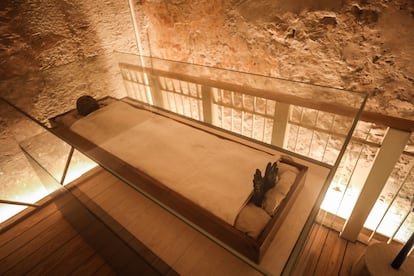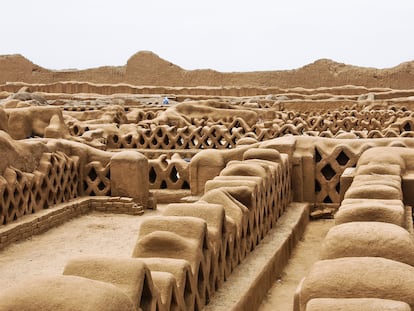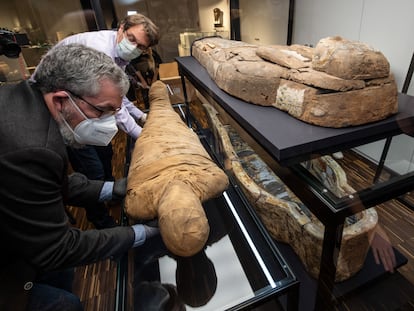Researchers find that an Egyptian mummy’s eternal balms smelled of pine, beeswax and bitumen
A study of the canopic vases of an ancient Egyptian lady provides new clues and raises new questions about the complex mummification process as well as the society’s trade links at the time

Ancient Egyptian society is popularly known for its tradition and refined rituals around death and the afterlife, especially for the ruling elites. Complex mummification processes were at the heart of this funerary culture, and they were practiced for nearly 4,000 years to preserve the deceased’s body and organs with an eye toward the afterlife.
Part of this sophisticated procedure involved meticulously removing the corpse’s organs so that the body would be better desiccated, thus facilitating their long-term preservation while awaiting the future return of the deceased’s soul. Often, these organs were also embalmed and preserved in containers known as canopic vessels.
Despite having been such a widespread practice over time, hardly any written sources detail this process, and there is no known ancient text that lists the ingredients used for preparing the balms used in mummification. The only available documents specifying ingredients are of Greek and Roman origin, but it is not certain that the process remained the same in the intervening centuries.
In an attempt to shed light on this question, a group of researchers recently analyzed balm residues found in canopic jars that once contained the mummified organs of an ancient Egyptian lady named Senetnay, who lived nearly 3500 years ago. Although the organs in question have been lost, the limestone jars — which British archaeologist Howard Carter found over a century ago in a tomb in the Valley of the Kings in southern Egypt — still retain partial traces of the balms inside, which allowed researchers to extract samples.
The results have revealed that the balms used in this case combined natural products and odorous ingredients; they were composed of a fine base of oils, fats, beeswax and bitumen mixed with Pinaceae resins. According to the study, published in the journal Scientific Reports, this is one of the most complex balms ever to be identified from such an early time in Ancient Egypt.
The researchers point out that the sophistication of the balms reflects and confirms the high social position of Senetnay, who is known to have been the wet nurse of pharaoh Amenhotep II, the son of Thutmose III. In this sense, her presence in the Valley of the Kings, a cemetery usually reserved for pharaohs and nobles, and the careful treatment given to her remains, also suggest that she was held in high regard by the ruler at the time and his entourage.
At the same time, the study notes that most of the ingredients found in Senetnay’s canopic vases were not of local origin but imported. In addition to further reinforcing the idea that the deceased was a prominent woman, this provides new information about ancient Egyptians’ commercial ties in the 2nd millennium BCE.
Vast trade networks
“The most surprising and interesting aspect of the research was discovering Ancient Egypt’s vast trade networks, especially in the mid-2nd millennium BC,” says Barbara Huber, one of the study’s lead researchers. “Discovering ingredients such as larch resin, native to the northern Mediterranean and Central Europe, and the possible presence of damar [resin], which comes exclusively from the tropical forests of Southeast Asia, was surprising,” she adds. “This paints the picture of a highly interconnected and globalized world in the middle of the 2nd millennium.”
Along with the new clues that the study offers about the balms used during the mummification process, analysis of Senetnay’s canopic jars also raises new questions. For instance, the balms in the two jars studied have a similar but not identical composition, and the proportions of the ingredients found in each are different. The researchers believe that these differences could be the result of the ingredients’ uneven degradation over the course of centuries, or a non-uniform distribution of the mummification balm. But at this point, they do not rule out the notion that the balms were organ-specific, which would imply an even more sophisticated procedure than previously thought.
In addition to studying the balms, the team has also decided to recreate their scent, which Huber notes will be part of an exhibition on Ancient Egypt that will open in October at the Moesgård Museum in Aarhus, Denmark. “The idea is to create a time machine and offer visitors a holistic, multisensory experience of ancient Egyptian life, death and afterlife rituals,” the researcher explains. Thus, she notes, “visitors will be able to have an olfactory bridge to the past, experiencing the mystery of mummification.”
Sign up for our weekly newsletter to get more English-language news coverage from EL PAÍS USA Edition
Tu suscripción se está usando en otro dispositivo
¿Quieres añadir otro usuario a tu suscripción?
Si continúas leyendo en este dispositivo, no se podrá leer en el otro.
FlechaTu suscripción se está usando en otro dispositivo y solo puedes acceder a EL PAÍS desde un dispositivo a la vez.
Si quieres compartir tu cuenta, cambia tu suscripción a la modalidad Premium, así podrás añadir otro usuario. Cada uno accederá con su propia cuenta de email, lo que os permitirá personalizar vuestra experiencia en EL PAÍS.
¿Tienes una suscripción de empresa? Accede aquí para contratar más cuentas.
En el caso de no saber quién está usando tu cuenta, te recomendamos cambiar tu contraseña aquí.
Si decides continuar compartiendo tu cuenta, este mensaje se mostrará en tu dispositivo y en el de la otra persona que está usando tu cuenta de forma indefinida, afectando a tu experiencia de lectura. Puedes consultar aquí los términos y condiciones de la suscripción digital.
More information
Últimas noticias
Most viewed
- Sinaloa Cartel war is taking its toll on Los Chapitos
- Oona Chaplin: ‘I told James Cameron that I was living in a treehouse and starting a permaculture project with a friend’
- Reinhard Genzel, Nobel laureate in physics: ‘One-minute videos will never give you the truth’
- Why the price of coffee has skyrocketed: from Brazilian plantations to specialty coffee houses
- Silver prices are going crazy: This is what’s fueling the rally











































